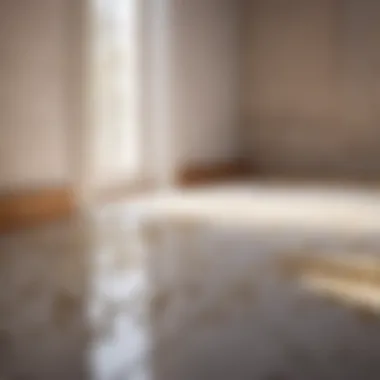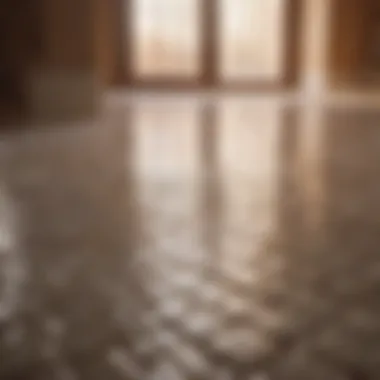Materials:
- Cementitious backer board: 1 sheet measuring 3 ft x 5 ft x 0.25 in
- Thin-set mortar: 1 bag of 50 lbs
- 1/4 inch notched trowel
- Tape measure
- Level
- Electric screw gun
- Screws: 1.25 inch
DIY Steps:
-
Assess Subfloor Condition: Begin by inspecting the subfloor for any damage, uneven areas, or moisture issues. Address and repair any issues before proceeding.
-
Prepare Subfloor Surface: Clean the subfloor thoroughly to remove debris, dust, and any adhesives. Ensure the surface is smooth and level for proper tile installation.
-
Install Cementitious Backer Board: Cut the backer board to fit the room dimensions and screw it into the subfloor using the electric screw gun and appropriate screws. Ensure proper spacing and secure attachment.
-
Apply Thin-Set Mortar: Mix the thin-set mortar according to the manufacturer's instructions. Using a trowel, spread the mortar evenly on the backer board surface, creating a consistent layer for tile adhesion.
Technical Aspects:
- Timing Specifics: Allow the mortar to set for the recommended time before placing tiles.
- Tools: Use a level to ensure the backer board is installed flat and even.
- Critical Techniques: Ensure proper trowel size and notch depth for adequate mortar coverage.
DIY Project Process:


- Lay out the tiles in the desired pattern before applying them with mortar.
- Press each tile firmly into the mortar, ensuring proper alignment and spacing.
- Use spacers to maintain consistent grout lines.
- Allow the tile to set before applying grout.
Troubleshooting Tips:


- If tiles are not adhering correctly, double-check the mortar consistency and coverage.
- In case of uneven tiles, adjust by gently tapping them with a rubber mallet to align properly.
Understanding Subfloor


Understanding the subfloor is a fundamental aspect of any tile installation project. The subfloor serves as the foundation for your tiles, supporting their weight and ensuring durability over time. By comprehensively assessing the subfloor, you can identify any underlying issues that may affect the finished results. Considering elements such as subfloor type, condition, and compatibility with tile materials is crucial in achieving a successful and long-lasting tile installation.
Types of Subfloors
Concrete Subfloor
Concrete subfloors are known for their strength and stability, making them a popular choice for tile installations. The key characteristic of a concrete subfloor lies in its resilience against moisture and structural integrity. This type of subfloor provides a solid base for various tile types, ensuring a sturdy foundation for your flooring project. However, concrete subfloors can be challenging to repair if cracks develop, requiring specialized techniques for optimal results.
Wood Subfloor
Wood subfloors are valued for their natural aesthetics and versatility in accommodating different types of tiles. The key characteristic of a wood subfloor is its ability to flex slightly, offering a more comfortable feel underfoot. While wood subfloors can add warmth to your space, they are susceptible to moisture damage and require proper sealing to prevent issues such as warping or mold growth. Despite their unique charm, wood subfloors may necessitate additional precautions to ensure compatibility with certain tile materials.
Plywood Subfloor
Plywood subfloors combine the durability of wood with added strength and stability. The key characteristic of a plywood subfloor is its uniform surface, ideal for achieving a level base for tile installation. Plywood subfloors offer excellent dimensional stability, reducing the risk of tiles shifting or cracking over time. However, proper sealing and moisture protection are essential to prevent moisture-related damage and maintain the integrity of the plywood subfloor.
Subfloor Inspection
Moisture Levels
Evaluating moisture levels in the subfloor is crucial for preventing issues such as tile adhesive failure or mold growth. The key characteristic of moisture levels lies in their impact on the adhesion and longevity of tile installations. Managing moisture levels ensures a dry and stable subfloor environment, promoting the effective bonding of tiles and preventing costly repairs in the future.
Flatness and Stability
Ensuring the flatness and stability of the subfloor is essential for achieving a professional and polished tile installation. The key characteristic of flatness and stability is their influence on the overall aesthetic and functionality of the tiled surface. A flat and stable subfloor minimizes lippage between tiles, creating a seamless and visually appealing finish. Addressing any irregularities promptly enhances the durability of the tile installation and prevents issues such as cracked or uneven tiles.
Preparing Subfloor for Tile Installation
Properly preparing the subfloor for tile installation is a critical step in ensuring the longevity and stability of your flooring. The surface upon which you install your tiles plays a significant role in the durability and overall success of the project. By taking the time to adequately prepare the subfloor, you can avoid potential issues such as cracked tiles, uneven surfaces, or premature wear and tear.
Cleaning the Subfloor
When it comes to cleaning the subfloor, there are two key aspects to consider: removing debris and dust and grease removal. These processes are essential in creating a clean and smooth surface for the tiles to adhere properly. Removal of debris involves clearing any loose particles, dirt, or foreign materials from the subfloor. This ensures that the tiles lay flat and securely without any obstructions. On the other hand, dust and grease removal focus on eliminating fine particles and oily residues that could hinder the adhesion of the tiles.
Removing Debris
Removing debris is crucial for achieving a level surface for tile installation. This process involves meticulously sweeping or vacuuming the subfloor to get rid of any loose materials. By ensuring a clean base, you reduce the risk of bumps or inconsistencies that may affect the final outcome of your tile project. Opting for debris removal sets the stage for a smooth and professional-looking tile installation.
Dust and Grease Removal
Dust and grease removal are equally important in preparing the subfloor for tiles. By removing these contaminants, you enhance the adhesion of the tiles and prevent potential issues such as gaps or bonding failures. Dust can act as a barrier between the tile and the adhesive, leading to poor adhesion and eventual tile movement. Grease residues, if not properly cleaned, can compromise the bonding strength, jeopardizing the longevity of your tile installation.
Priming the Subfloor
In addition to cleaning, priming the subfloor is essential for optimizing the surface for tile installation. Priming involves applying a preparatory coat that enhances adhesion and acts as a moisture barrier. By priming the subfloor, you improve the bonding between the tiles and the adhesive, creating a strong foundation for the installation.
Improving Adhesion
Improving adhesion through priming enhances the bond between the subfloor and the tiles. This step ensures that the tiles remain securely in place, resisting displacement and ensuring long-lasting durability. The adhesive properties of the primer create a solid connection that can withstand daily wear and tear, prolonging the life of the tile installation.
Moisture Barrier Application
Moisture barrier application is crucial in areas prone to high humidity or moisture exposure. By applying a moisture barrier, you safeguard the subfloor against water damage, mold growth, and warping. This protective layer prevents moisture from seeping into the subfloor, preserving the integrity of the installation and contributing to its longevity.
Layout Planning
Layout planning is an essential aspect of subfloor preparation that involves determining the placement and pattern of the tiles. Proper layout planning ensures a visually appealing design and optimal use of materials. By strategically arranging the tiles and aligning them correctly, you create a cohesive and aesthetically pleasing tile installation.
Tile Alignment
Tile alignment focuses on positioning the tiles in a straight and uniform manner. This meticulous process requires attention to detail and precision to ensure that the tiles are evenly spaced and aligned. Proper tile alignment enhances the overall aesthetics of the flooring and showcases the craftsmanship and dedication put into the installation.
Tile Patterns
Choosing the right tile patterns can transform the look and feel of a space. Whether opting for a classic layout or experimenting with unique designs, tile patterns play a significant role in the visual impact of the flooring. By selecting complementary patterns and incorporating creative layouts, you can personalize your tile installation and add character to the room.
Optimizing Subfloor Conditions
Moisture Control
Waterproofing Measures
Waterproofing measures play a pivotal role in preventing water damage and preserving the integrity of the subfloor. By applying waterproofing membranes or coatings, homeowners can create a protective barrier that shields the subfloor from moisture infiltration. This not only helps in maintaining the structural integrity of the subfloor but also prevents mold and mildew growth, which can compromise the quality of the tile installation. The key characteristic of waterproofing measures lies in their ability to create a watertight seal, ensuring that moisture does not seep through the subfloor and affect the tiles above. While waterproofing measures are a popular choice for enhancing subfloor durability, it is essential to consider the compatibility of the waterproofing material with the tile adhesive to avoid any adhesion issues. Overall, incorporating waterproofing measures in subfloor optimization is crucial for ensuring the longevity and performance of the tiled flooring.
Sealing Joints
Sealing joints is another vital aspect of moisture control when optimizing the subfloor for tile installation. Properly sealing the joints between subfloor panels or planks helps prevent water seepage and minimizes the risk of moisture-related damage. The key characteristic of sealing joints is its ability to create a tight seal that eliminates gaps where water could penetrate, safeguarding the subfloor from moisture intrusion. While sealing joints is a beneficial choice for enhancing subfloor integrity, it is important to ensure that the sealant used is compatible with the subfloor material to prevent any chemical reactions or deterioration over time. Additionally, regular inspections and maintenance of sealed joints are necessary to address any wear or damage that may compromise the effectiveness of the seal. Incorporating sealing joints as part of the subfloor optimization process is essential for mitigating moisture issues and promoting the longevity of the tile installation.
Temperature and Humidity Regulation
Climate Considerations
Considering the impact of climate on subfloor conditions is crucial when optimizing for tile installation. Climate considerations involve assessing factors such as temperature fluctuations and humidity levels in the environment where the tiles will be installed. This information helps homeowners select the appropriate materials and adhesives that can withstand the specific climate conditions, ensuring long-term performance and durability. The key characteristic of climate considerations is their ability to guide homeowners in making informed decisions regarding subfloor preparation and material selection based on the prevailing climate. While climate considerations are a beneficial choice for optimizing subfloors, it is important to consult with professionals or experts to ensure the chosen materials can withstand the environmental conditions in the long run. Overall, integrating climate considerations into the subfloor optimization process enables homeowners to create a resilient foundation that can endure varying climate challenges.
AC Installation Impact
The impact of AC installation on subfloor conditions is another crucial factor to consider when optimizing for tile installation. Air conditioning systems can affect the temperature and humidity levels within a space, directly influencing the stability and performance of the subfloor. Understanding how AC installation impacts subfloor conditions allows homeowners to adapt their subfloor optimization strategies to account for climate control requirements. The key characteristic of AC installation impact is its ability to regulate indoor climate and create a conducive environment for tile installation. While AC installation impact is a popular choice for enhancing subfloor conditions, it is essential to ensure that the AC system is correctly sized and maintained to prevent excessive moisture accumulation or temperature fluctuations that could compromise the subfloor integrity. By addressing the impact of AC installation on subfloor conditions, homeowners can create an environment that supports the long-term durability and functionality of their tiled floors.
Soundproofing Techniques
Underlayment Installation
The installation of underlayment is a key aspect of optimizing subfloor conditions for tile installation. Underlayment serves as a buffer between the subfloor and the tiles, providing cushioning and sound absorption properties. By incorporating underlayment during the subfloor preparation stage, homeowners can reduce noise transmission, enhance thermal insulation, and improve overall comfort underfoot. The key characteristic of underlayment installation lies in its ability to improve the acoustic performance of the tiled floor, creating a quieter and more peaceful indoor environment. While underlayment installation is a beneficial choice for optimizing subfloors, it is important to select the appropriate underlayment material that complements the tile flooring system for optimal results. Additionally, professional installation of underlayment is recommended to ensure proper alignment and coverage, contributing to the longevity and performance of the tiled floors.
Sound Absorption Materials
The use of sound absorption materials is essential in soundproofing subfloors for tile installation. Sound absorption materials, such as cork or rubber underlayment, help minimize sound transfer between floors, creating a quieter and more comfortable living environment. These materials absorb impact noise generated from foot traffic or other sources, reducing sound transmission and enhancing acoustic comfort. The key characteristic of sound absorption materials is their ability to improve the overall sound insulation of the tiled floor, contributing to a serene and peaceful atmosphere within the home. While sound absorption materials are a popular choice for optimizing subfloors, homeowners should ensure proper installation and coverage to maximize their effectiveness. Incorporating sound absorption materials as part of the subfloor optimization process plays a significant role in enhancing the acoustics and comfort of the tile installation, providing homeowners with a more enjoyable living space.
Conclusion
In the realm of optimizing subfloor conditions for tile installation, the conclusion serves as the pivotal point where all the meticulous planning and execution efforts culminate. Within the context of this detailed guide, the significance of the conclusion cannot be overstated. It acts as the final touchpoint that ultimately determines the longevity and effectiveness of the tile installation process. By focusing on key elements such as proper maintenance and periodic inspections, homeowners can ensure the sustainability and functionality of their tiled surfaces for years to come.
Ensuring Longevity
Proper Maintenance
Proper maintenance stands as a cornerstone in the realm of subfloor optimization for tile installation. It involves regular upkeep to preserve the quality and integrity of the subfloor to support the tiles adequately. Emphasizing proper maintenance translates to a proactive approach in safeguarding against potential damages or wear and tear. One of the key characteristics of proper maintenance is its preventive nature, preempting issues before they escalate and become costly to rectify. Homeowners benefit from this approach as it minimizes the need for extensive repairs in the future, promoting cost-effectiveness and sustainable tile longevity. The unique feature of proper maintenance lies in its ability to enhance the resilience of the subfloor, ensuring a robust foundation that underpins the durability of the tile installation. While the advantages of proper maintenance are evident in its ability to prolong the lifespan of tile flooring, one potential disadvantage may be the requirement for consistent attention and effort from homeowners.
Periodic Inspections
Periodic inspections play a vital role in upholding the longevity and functionality of tile flooring. By conducting routine inspections, homeowners can proactively address any emerging issues or concerns related to the subfloor condition. The key characteristic of periodic inspections lies in their diagnostic nature, enabling early detection of potential problems that could compromise the tile installation. Opting for periodic inspections proves to be a popular choice in this article due to its proactive approach in ensuring the structural integrity of the subfloor. The unique feature of periodic inspections is their ability to identify hidden issues that may not be apparent during regular maintenance routines, thereby enhancing the overall robustness of the subfloor. The advantages of periodic inspections are manifold, ranging from enhanced safety and stability to cost-saving benefits by addressing issues before they escalate. However, one potential disadvantage could be the occasional inconvenience of scheduling and conducting these inspections, requiring homeowners to allocate time and resources for this essential upkeep.





